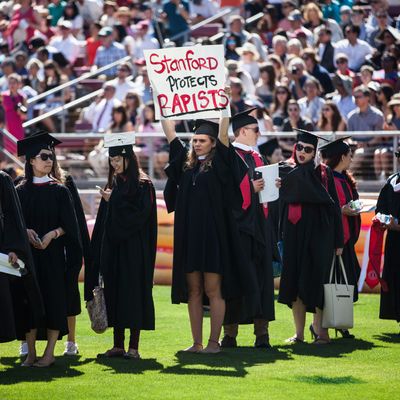
In 2015, a panel of five Stanford University administrators, faculty, and students convened to decide whether a student had been sexually assaulted by a football player she met on campus. After hearing evidence, three of the panelists ruled the man had committed sexual assault, but two found that he had not. At the time, Stanford required a 4-1 majority to find the accused responsible. So despite the fact that a simple majority ruled he was, the student faced no consequences.
The woman who accused him appealed the case twice, and she spoke to the New York Times about Stanford’s system for handling sexual-assault cases, which she called “so inequitable and unfair” that it violated her rights under Title IX. “All I really wanted was a no-contact order,” she told the Times. “I wanted little things to make being on campus more bearable … that’s what kept me moving forward.”
She described the investigation process as riddled with inconsistencies:
She began the hearing feeling that the deck was stacked against her. She said that only the night before did she see the accused’s statement for the first time, and that it included new statements from two of his football teammates. She said she had exchanged emails with an administrator in May and June 2015 and “not once” did that administrator “indicate that any other files had been added to the investigation file, nor did she respond to my previous questions regarding the investigation file,” according to her appeal, which included the email exchange with an assistant dean coordinating the process.
When she asked to postpone the hearing so she could ask for redactions of statements that she deemed prejudicial as well as suggest follow-up questions for an investigator to ask the witnesses, she said she was denied without an explanation.
“I was told to stick to the facts on my statement, and I did,” she said. “He was allowed to speculate on why I ‘targeted’ him. His teammates, who were not even involved in that night, basically said he was a great guy and was being punished for consensual sex.”
The panel proceeded anyway, with only three of five panelists finding the accused responsible. The student appealed, and the second panel also came back 3-2. When she appealed a third time, her request was denied.
Stanford has since changed its system; in February 2016, the school decided panels would only include three members and must rule unanimously that a sexual assault has occurred in order to find the accused responsible. But some say this system is even more flawed. “The victim should not need to garner three votes to win while the respondent needs to garner only one,” said Michele Dauber, a Stanford law professor and a critic of the university’s sexual-assault policies. “That is basic inequity.”
In addition to complaints and protests from students, the school is also the subject of a lawsuit by four different women that says it acted “indifferently” to claims of sexual assault. In response to that suit, a spokesperson for Stanford said the university believes its Title IX process is “effective and fair.”




